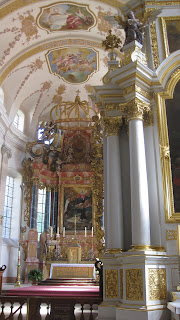It was a joy : as our photos show. It has been fun to select videos to try to give you the atmosphere of this remarkable building. Do take a look if you are in the area. One day I'll be back to hear the organ!
The Abbey, dedicated to Saint Maurice, was founded in 667 by Saint Deodatus of Nevers on the island of Novientum in the River Ill. using relics of Saint Maurice which Deodatus had obtained from St Maurice's Abbey.Thanks to the support of Adalrich, Duke of Alsace, father of Saint Odilia, this Benedictine monastery flourished.It was destroyed by the Swedes during the Thirty Years War of 1618-48 and was not rebuilt until the early 18th century. The architect was the Austrian, Peter Thumb. Then lightning caused a disastrous fire in 1717 and Peter Thumb was recalled to do a rebuild. He incorporated several of surviving parts, including the seven sided apse, the square crossing with the same width as the choir and the tall shafts of the three towers, two on the west front and one behind at the back of the apse. The latter is very unusual and recalls Carolingian churches, It is this 3 tower feature that is most memorable. This rebuilding began in 1719 with a staggering 200 assistants to Thumb. It must have been a rich foundation! By 1727 the structural work was done, and decoration was underway. The frescos were completed 1728-1759.Furnishings completed by 1735. The interior is impressive and shows characteistics of Thumb's Voralberg style further west than ever seen before.
The above video gives a lovely little tour of the interior with Gregorian chant baackgound.
The abbey was dissolved during the French Revolution and the conventual buildings were demolished. The contents of the library were taken to Strasbourg, where most of them were burnt in the market place. The site was reoccupied in 1829 by a community of Marianist Brothers and Priests and from 1887 by the Sisters of St Joseph of Saint-Marc.

 |
| Confessionals complted 1733-5 |
 |
| Model of Ebersmunster in the 18th century |
 |
| Silbermann organ The church is justly famous for its wonderful Silbermann organ. |
n












No comments:
Post a Comment